
A cathode-ray tube (CRT) is a vacuum tube containing one or more electron guns, which emit electron beams that are manipulated to display images on a phosphorescent screen. The images may represent electrical waveforms (oscilloscope), pictures, radar targets, or other phenomena. A CRT on a television set is commonly called a picture tube. CRTs have also been used as memory devices, in which case the screen is not intended to be visible to an observer. The term cathode ray was used to describe electron beams when they were first discovered, before it was understood that what was emitted from the cathode was a beam of electrons.
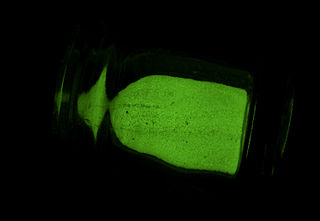
A phosphor is a substance that exhibits the phenomenon of luminescence; it emits light when exposed to some type of radiant energy. The term is used both for fluorescent or phosphorescent substances which glow on exposure to ultraviolet or visible light, and cathodoluminescent substances which glow when struck by an electron beam in a cathode ray tube.

The Selectron was an early form of digital computer memory developed by Jan A. Rajchman and his group at the Radio Corporation of America (RCA) under the direction of Vladimir K. Zworykin. It was a vacuum tube that stored digital data as electrostatic charges using technology similar to the Williams tube storage device. The team was never able to produce a commercially viable form of Selectron before magnetic-core memory became almost universal.

An electron gun is an electrical component in some vacuum tubes that produces a narrow, collimated electron beam that has a precise kinetic energy. The largest use is in cathode ray tubes (CRTs), used in nearly all television sets, computer displays and oscilloscopes that are not flat-panel displays. They are also used in field emission displays (FEDs), which are essentially flat-panel displays made out of rows of extremely small cathode ray tubes. They are also used in microwave linear beam vacuum tubes such as klystrons, inductive output tubes, travelling wave tubes, and gyrotrons, as well as in scientific instruments such as electron microscopes and particle accelerators. Electron guns may be classified by the type of electric field generation, by emission mechanism, by focusing, or by the number of electrodes.

Tektronix, Inc., historically widely known as Tek, is an American company best known for manufacturing test and measurement devices such as oscilloscopes, logic analyzers, and video and mobile test protocol equipment.
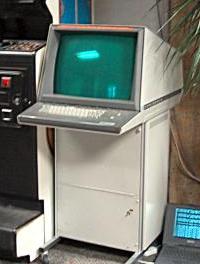
The Tektronix 4010 series was a family of text-and-graphics computer terminals based on storage-tube technology created by Tektronix. Several members of the family were introduced during the 1970s, the best known being the 11-inch 4010 and 19-inch 4014, along with the less popular 25-inch 4016. They were widely used in the computer-aided design market in the 1970s and early 1980s.
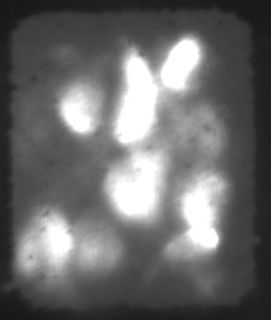
A field-emission display (FED) is a flat panel display technology that uses large-area field electron emission sources to provide electrons that strike colored phosphor to produce a color image. In a general sense, an FED consists of a matrix of cathode ray tubes, each tube producing a single sub-pixel, grouped in threes to form red-green-blue (RGB) pixels. FEDs combine the advantages of CRTs, namely their high contrast levels and very fast response times, with the packaging advantages of LCD and other flat-panel technologies. They also offer the possibility of requiring less power, about half that of an LCD system.

Storage tubes are a class of cathode-ray tubes (CRTs) that are designed to hold an image for a long period of time, typically as long as power is supplied to the tube.
The penetron, short for penetration tube, is a type of limited-color television used in some military applications. Unlike a conventional color television, the penetron produces a limited color gamut, typically two colors and their combination. Penetrons, and other military-only cathode ray tubes (CRTs), have been replaced by LCDs in modern designs.

A raster scan, or raster scanning, is the rectangular pattern of image capture and reconstruction in television. By analogy, the term is used for raster graphics, the pattern of image storage and transmission used in most computer bitmap image systems. The word raster comes from the Latin word rastrum, which is derived from radere ; see also rastrum, an instrument for drawing musical staff lines. The pattern left by the lines of a rake, when drawn straight, resembles the parallel lines of a raster: this line-by-line scanning is what creates a raster. It is a systematic process of covering the area progressively, one line at a time. Although often a great deal faster, it is similar in the most general sense to how one's gaze travels when one reads lines of text. The data to be drawn is stored in an area of memory called the refresh buffer or frame buffer. This memory area holds the values for each pixel on the screen. These values are retrieved from the refresh buffer and painted onto the screen one row at a time.
Dicomed was a computerized graphics technology company founded in 1968 and based in Minneapolis. In the early 1970s it became a leading manufacturer of precision color film recorders such as the D47 and D48.

A vector monitor, vector display, or calligraphic display is a display device used for computer graphics up through the 1970s. It is a type of CRT, similar to that of an early oscilloscope. In a vector display, the image is composed of drawn lines rather than a grid of glowing pixels as in raster graphics. The electron beam follows an arbitrary path tracing the connected sloped lines, rather than following the same horizontal raster path for all images. The beam skips over dark areas of the image without visiting their points.

An oscilloscope is a type of electronic test instrument that graphically displays varying electrical voltages as a two-dimensional plot of one or more signals as a function of time. The main purposes are to display repetitive or single waveforms on the screen that would otherwise occur too briefly to be perceived by the human eye. The displayed waveform can then be analyzed for properties such as amplitude, frequency, rise time, time interval, distortion, and others. Originally, calculation of these values required manually measuring the waveform against the scales built into the screen of the instrument. Modern digital instruments may calculate and display these properties directly.
The Chromatron is a color television cathode ray tube design invented by Nobel prize-winner Ernest Lawrence and developed commercially by Paramount Pictures, Sony, Litton Industries and others. The Chromatron offered brighter images than conventional color television systems using a shadow mask, but a host of development problems kept it from being widely used in spite of years of development. Sony eventually abandoned it in favor of their famous Trinitron system using an aperture grille.
Electrically operated display devices have developed from electromechanical systems for display of text, up to all-electronic devices capable of full-motion 3D color graphic displays. Electromagnetic devices, using a solenoid coil to control a visible flag or flap, were the earliest type, and were used for text displays such as stock market prices and arrival/departure display times. The cathode ray tube was the workhorse of text and video display technology for several decades until being displaced by plasma, liquid crystal (LCD), and solid-state devices such as thin-film transistors (TFTs), LEDs and OLEDs. With the advent of metal-oxide-semiconductor field-effect transistors (MOSFETs), integrated circuit (IC) chips, microprocessors, and microelectronic devices, many more individual picture elements ("pixels") could be incorporated into one display device, allowing graphic displays and video.
The skiatron is a type of cathode ray tube (CRT) that replaces the conventional phosphor with some type of scotophor, typically potassium chloride.
A scotophor is a material showing reversible darkening and bleaching when subjected to certain types of radiation. The name means dark bearer, in contrast to phosphor, which means light bearer. Scotophors show tenebrescence and darken when subjected to an intense radiation such as sunlight. Minerals showing such behavior include hackmanite sodalite, spodumene and tugtupite. Some pure alkali halides also show such behavior.
This is a subdivision of the Oscilloscope article, discussing the various types and models of oscilloscopes in greater detail.
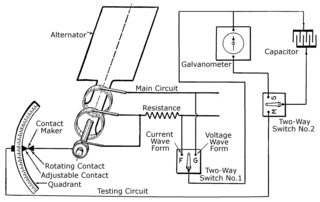
The history of the oscilloscope reaches back to the first recordings of waveforms with a galvanometer coupled to a mechanical drawing system in the second decade of the 19th century. The modern day digital oscilloscope is a consequence of multiple generations of development of the oscillograph, cathode-ray tubes, analog oscilloscopes, and digital electronics.
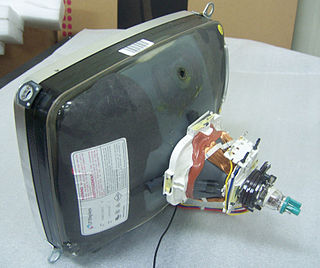
A deflection yoke is a kind of magnetic lens, used in cathode ray tubes to scan the electron beam both vertically and horizontally over the whole screen.











